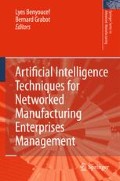Abstract
The recent financial crisis has had a major negative impact on the global economy, and particularly had a significant impact on the global manufacturing industry due to the ever-decreasing customer demand. For manufacturing enterprises, especially those who run businesses in multiple countries, it is now a good time to operate in a smarter way and lead the new era that is taking shape underneath the present crisis. We introduce a multi-agent-based simulation tool in this chapter, with a description of the overall architecture, modelling elements, operational policies, etc. The tool has been used in a commercial project with a leading high-tech manufacturer. The complex relationships between service levels, inventory cost, transportation cost, and forecasting accuracy were well studied. The project results show that networked enterprises can really get better insight from such a quantitative analysis and would be able to identify solid opportunities for cost saving and performance improvement.
Access this chapter
Tax calculation will be finalised at checkout
Purchases are for personal use only
Preview
Unable to display preview. Download preview PDF.
References
Bagchi S, Buckley SJ, Ettl M et al. (1998) Experience using the IBM supply chain simulator. In: Proceedings of the 1998 Winter Simulation Conference, pp. 1387–1394
Banks J, Buckley S, Jain S et al. (2002) Panel session: opportunities for simulation in supply chain management. In: Proceedings of the 2002 Winter Simulation Conference, pp. 1652–1658
Brun A, Cavalieri S, Macchi M et al. (2002) Distributed simulation for supply chain coordination. In: Proceedings of the 12th International Working Seminar on Production Economics, Igls, Austria
Chen F, Drezner Z, Ryan JK et al. (2000) Quantifying the bullwhip effect in a simple supply chain: The impact of forecasting lead times, and information. Mgmt Sci., 46(3):436–443
Cloutier L, Frayret JM, D’Amours S et al. (2001) A commitment-oriented framework for networked manufacturing coordination. Int. J. Comput. Integr. Manuf. 14:522–534
Dong J, Ding H, Ren C et al. (2006) IBM SmartSCOR–A scor based supply chain transformation platform. In: Proceedings of the 2006 Winter Simulation Conference, pp. 650–659
Fox MS, Barbuceanu M, Teigen R (2000) Agent-oriented supply chain management. Int. J. Flex. Manuf. Syst. 12(2/3):165–188
Gan BP, Low Y, Lim C et al. (2000) Parallel discrete-event simulation of a supply chain in semiconductor industry. In: Proceedings of HPC ASIA
Kaelbling LP, Littman ML, Moore AW (1996) Reinforcement learning: A survey. J. Artif. Intell. Res., 4:237–285
Kimbrough SO, Wu D, Zhong F (2002) Computers play the beer game: can artificial agents manage supply chains?. Decis. Support Syst., 33(3):323–333
Kleijnen JPC (2003) Supply chain simulation: A survey. Int. J. Simul. Process Mod., 103:1–20
Law AM, Kelton WD (2000) Simulation modeling and analysis, third edition, McGraw-Hill, Boston, MA
Lendermann P, Julka N, Gan BP et al. (2003) Distributed supply chain simulation as a decisionsupport tool for the semiconductor industry. Simulation 79(3):126–138
Mondal S, Tiwari MK (2003) Formulation of mobile agents for integration of supply chain using the KLAIM concept. Int. J. Prod. Res., 41(1):97–119
Nissen ME (2000) Agent-based supply chain disintermediation versus reintermediation: Economic and technological perspectives. Int. J. Intell. Syst. Account., Fin. Mgmt, 9:237–256
Pontrandolfo P, Gosavi A, Okogbaa OG et al. (2002) Global supply chain management: a reinforcement learning approach. Int. J. Prod. Res., 40(6):1299–1317
Qiu M, Ding H, Dong J et al. (2007) Impact of business service modes on distribution systems: a reinforcement learning approach. In: Proceedings of the International Conference on Services Computing, July
Repast (2008) http://repast.sourceforge.net/
Rubinstein RY, Kroese DP (2007) Simulation and the Monte Carlo method. Wiley-Interscience
Sadeh-Koniecpol N, Hildum D, Kjenstad D et al. (1999) MASCOT: An agent-based architecture for coordinated mixed-initiative supply chain planning and scheduling. In: Proceedings of the 3rd International Conference on Autonomous Agents (Agents '99), May
Scalable Simulation Framework (SSF) (2008) http://www.ssfnet.org/homePage.html
Shen W, Kremer R, Ulieru M et al. (2003) A collaborative agent-based infrastructure for internetenabled collaborative enterprise. Int. J. Prod. Res., 41(8):1621–1638
Sudra R, Taylor SJ, Janahan T (2000) Distributed supply chain simulation in GRIDS. In: Proceedings of the 2000 Winter Simulation Conference, pp.356–361
Sutton RL, Barto AG (1998) Reinforcement leaning–An introduction, MIT Press, Massachusetts
Swaminathan JM (1997) Modeling supply chain dynamics: a multi-agent approach. Decis. Sci., 29(3):607–632
Terzi, S, Cavalieri S (2004) Simulation in the supply chain context: A survey. Comput. Ind., 53: 3–16
Towill DR, Naim MM, Wikner J (1992) Industrial dynamics simulation models in the design of supply chains. Int. J. Physical Distrib. Logist. Manag., 22(5):3–13
Tzafestas S, Kapsiotis G (1994) Coordinated control of manufacturing/supply chains using multi-level techniques. Comput. Integr. Manuf. Syst., 7(3):206–212
Wang W, Dong J, Ding H et al. (2008) An introduction to IBM general business simulation environment. In: Proceedings of the 2008 Winter Simulation Conference, pp.2700–2707
Author information
Authors and Affiliations
Corresponding author
Editor information
Editors and Affiliations
Rights and permissions
Copyright information
© 2010 Springer-Verlag London Limited
About this chapter
Cite this chapter
Ding, H., Wang, W., Qiu, M., Dong, J. (2010). Multi-agent Simulation-based Decision Support System and Application in Networked Manufacturing Enterprises. In: Benyoucef, L., Grabot, B. (eds) Artificial Intelligence Techniques for Networked Manufacturing Enterprises Management. Springer Series in Advanced Manufacturing. Springer, London. https://doi.org/10.1007/978-1-84996-119-6_3
Download citation
DOI: https://doi.org/10.1007/978-1-84996-119-6_3
Publisher Name: Springer, London
Print ISBN: 978-1-84996-118-9
Online ISBN: 978-1-84996-119-6
eBook Packages: EngineeringEngineering (R0)

